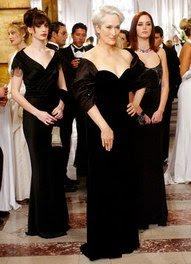

There are many links to popular culture and teenage girls having negative attitudes towards themselves. They do focus on their looks, and especially what they do not like about themselves. Marketing and advertising agencies spend millions of dollars per year to target these "insecure" girls, who will spend all of their money on products that they believe will help them to look good.
If you have seen the movie "The Devil wears Prada" you will know that the fashion industry pressures women and young girls in to being thin and sexy. Even Meryl Streep, who plays Miranda the editor-in-chief of "Runway" fashion magazine, seems to be somewhat thinner than usual, in order to "fulfi"l the role. When interviewed by IndieLONDON (a virtual, online magazine) Streep said "I did lose a few pounds, I think that was just anxiety. There was a lot of anxiety in this character. Everybody says, was it fun to play a villain? No. It was not fun to be in this person’s body, it just wasn’t at all." (The full interview can be viewed at
http://www.indielondon.co.uk/Film-Review/the-devil-wears-prada-meryl-streep-interview)
Do you believe her? Do you really think that Streep lost all that weight without the aide of strict dieting and exercise? Afterall, as you age your metabolism does slow down. Researchers have found that "Basal metabolic rate (BMR) is the amount of energy expended while at rest in a neutrally temperate environment, in the post-absorptive state (meaning that the digestive system is inactive, which requires about twelve hours of fasting in humans). The release of energy in this state is sufficient only for the functioning of the vital organs, such as the heart, lungs, brain and the rest of the nervous system, liver, kidneys, sex organs, muscles and skin. BMR decreases with age and with the loss of lean body mass"
Who is the real villain in this saga? The answer is plain and simple; The media. They portray unrealistic ideals of thin, sexy, super-models in magazines and on billboards. They airbrush models to perfection to make the unattainable seem attainable. Take a look at this you tube video Getting Real to see the real effects of popular culture on teenage girls and what actually goes on behind the scenes in advertising, marketing, magazines etc.
COMMENTARY:
I have chosen the issue of the media influences on self-esteem to prove to young girls and older women that they are already beautiful individuals, without trying to achieve an unrealistic image of perfection. There is no need to change yourself to please others, as everyone is an individual; we all look different and we are the ones who have to live with ourselves.
My pictures were carefully chosen, as I wanted to show girls how they could end up if they let the media "suck them in" with popular culture images.
The image of the anorexic model is a realistic portrayal of what is happening to many girls because of the media. Anorexia Nervosa is a serious illness and should not be taken lightly as researchers have found that girls as young as eight years-ole have been known to diet.
The picture of Merryl Streep in "The Devil wears Prada" proves that even older women (including Streep herself) are feeling the pressure to be thin and sexy.
By including the YouTube video, this blog site captures the essence of what the media has been getting away with for so many years. It is an issue that, the media itself, will not exploit as they are making far too much money from the industry with fashion advertising, product advertisements on billboards and in magazines for girls etc.
This particular video shows interviews of girls who say that they wish they were thinner or that they have already tried to change themselves in some way. A ten year-old girl even comments that the wants to go on a raw fish diet to lose weight!
The media really does target the insecurities of young girls (and older women) with advertisements for make- up, tanning lotions, anti-aging products, (targeted at older women) blemish treatments, other skin creams etc. It really upsets me to find that when girls try these products, (which may be endorsed by beautiful, famous actresses or models) they believe it make them beautiful too.
What women and girls of all ages need to know is that no matter how hard they try, they cannot look like the air-brushed, bronzed babe with perfect skin from the advertisement, as she is a fake to begin with. What you see in the magazine is not real and is definately not something that could be achieved in real life.
To conclude, I would like to remind girls of all ages that they are real and natural and should not fall for the popular culture images, as they are fake and misleading. Be happy with who you are and what you are. It is wrong of the media to target your insecurities and develop them in to a tool for making money.

